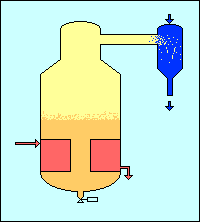How Cane Sugar is Made - Boiling

Physical chemistry assists with sugar purification during the crystallisation process because there is a natural tendency for the sugar crystals to form as pure sucrose, rejecting the non-sugars. Thus, when the sugar crystals are grown in the mother liquor they tend to be pure and the mother liquor becomes more impure. Most remaining non-sugar in the product is contained in the coating of mother liquor left on the crystals
The mother liquor still contains valuable sugar of course so the crystallisation is repeated several times. However non-sugars inhibit the crystallisation. This is particularly true of other sugars such as glucose and fructose which are the breakdown products of sucrose. Each subsequent step therefore becomes more difficult until one reaches a point where it is no longer viable to continue.
The crystallisation step itself - a "boiling" - takes place in a vacuum pan: a large closed kettle with steam heated pipes. [In practice the heating is done with a low pressure water vapour from the evaporator.] Some modern pans are continuous flow devices but most are batch devices which go through a discrete cycle and are then emptied for a new boiling. A typical cycle might be 4 hours long. The mixture of crystals and mother liquor from a boiling, called the "massecuite", is dropped into a receiving tank called a crystalliser where it is cooled down and the crystals continue to grow. This also releases the pan for a new boiling. From the crystalliser the massecuite is fed to the centrifuges.
In a raw sugar factory it is normal to conduct three boilings. The first or "A" boiling produces the best sugar which is sent to store. The "B" boiling takes longer and the retention time in the crystalliser is also longer if a reasonable crystal size is to be achieved. Some factories re-melt the B sugar to provide part of the A boiling feedstock, others use the crystals as seed for the A boilings and others mix the B sugar with the A sugar for sale. The "C" boiling takes proportionally longer than the B boiling and considerably longer to crystallise. The sugar is usually used as seed for B boilings and the rest is re-melted.



| 